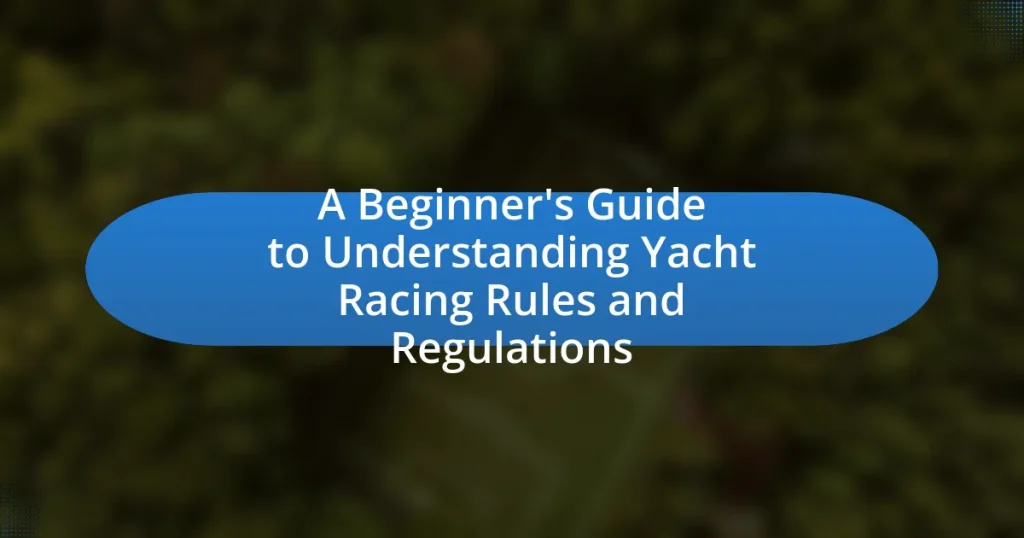The article provides a comprehensive overview of yacht racing rules and regulations, primarily governed by the Racing Rules of Sailing (RRS) established by World Sailing. It outlines the fundamental principles that dictate the conduct of yacht races, including competitors’ rights and obligations, starting and finishing procedures, and penalties for violations. The article also highlights the differences between yacht racing rules and those of other sports, the role of governing bodies, and the importance of understanding these regulations for fair competition and safety. Additionally, it offers practical tips for beginners on how to learn and navigate these rules effectively, ensuring a solid foundation for participating in yacht racing.

What are the fundamental yacht racing rules and regulations?
The fundamental yacht racing rules and regulations are primarily governed by the Racing Rules of Sailing (RRS), which are established by World Sailing. These rules dictate the conduct of yacht races, including the rights and obligations of competitors, the procedures for starting and finishing races, and the penalties for rule violations. For example, Rule 10 states that boats on opposite tacks must keep clear of each other, while Rule 14 requires boats to avoid contact unless they are required to give way. These regulations ensure fair competition and safety on the water, and they are updated periodically to reflect changes in the sport.
How do yacht racing rules differ from other sports?
Yacht racing rules differ from other sports primarily due to their reliance on maritime regulations and the unique nature of wind and water as competitive elements. Unlike many sports that have fixed playing fields and equipment, yacht racing involves variable conditions such as wind direction, water currents, and weather, which significantly influence race outcomes. Additionally, yacht racing adheres to the Racing Rules of Sailing, established by the International Sailing Federation, which incorporates specific rules for interactions between boats, right-of-way situations, and penalties that are distinct from rules in land-based sports. For example, the concept of “starboard tack” and “port tack” is unique to sailing, determining which boat has the right of way in various scenarios, a concept not found in most other sports.
What are the key governing bodies for yacht racing rules?
The key governing bodies for yacht racing rules are World Sailing, the International Sailing Federation, and national authorities such as the United States Sailing Association. World Sailing is responsible for establishing and updating the Racing Rules of Sailing, which are used globally. The International Sailing Federation oversees international competitions and ensures compliance with these rules. National authorities implement these rules at the country level, adapting them as necessary for local events.
How do international and local regulations interact?
International and local regulations interact through a framework where international laws set broad standards that local jurisdictions must implement or adapt to their specific contexts. For instance, the International Sailing Federation (ISAF) establishes rules that govern yacht racing globally, which local sailing authorities then incorporate into their own regulations, ensuring compliance while addressing regional conditions. This interaction is essential for maintaining consistency in yacht racing while allowing for local adaptations that reflect specific environmental, cultural, or legal factors.
Why is it important to understand yacht racing rules?
Understanding yacht racing rules is crucial for ensuring fair competition and safety on the water. These rules govern the conduct of races, dictate the rights and responsibilities of competitors, and help prevent disputes. For instance, the Racing Rules of Sailing, established by World Sailing, provide a standardized framework that all participants must follow, which enhances the integrity of the sport. Additionally, familiarity with these rules allows sailors to make informed decisions during races, improving their strategic positioning and overall performance. This knowledge is essential not only for compliance but also for fostering a respectful and sportsmanlike environment among competitors.
What are the consequences of not following the rules?
Not following the rules in yacht racing can lead to disqualification from the race. Disqualification occurs when a competitor fails to adhere to the established regulations, which are designed to ensure fair competition and safety. For example, the Racing Rules of Sailing outline specific penalties for various infractions, such as starting early or failing to give way to another vessel. These penalties can include time penalties, points deductions, or outright disqualification, which can significantly impact a team’s standings and reputation in the sport.
How can knowledge of the rules enhance racing performance?
Knowledge of the rules enhances racing performance by enabling sailors to make informed decisions that optimize their strategies and maneuvers. Understanding the rules allows competitors to avoid penalties, which can significantly impact race outcomes; for instance, a sailor who knows the right of way can navigate more effectively and maintain speed without risking disqualification. Additionally, familiarity with the rules helps sailors anticipate competitors’ actions, allowing for strategic positioning and tactical advantages during races. This knowledge is supported by the fact that many successful sailors attribute their victories to a deep understanding of the racing regulations, which informs their tactical choices and enhances overall performance.

What are the main categories of yacht racing rules?
The main categories of yacht racing rules are the Racing Rules of Sailing, class rules, and local sailing instructions. The Racing Rules of Sailing, established by World Sailing, govern the conduct of yacht racing globally and include rules on racing procedures, rights of way, and penalties. Class rules are specific to individual yacht classes and dictate design and measurement standards to ensure fair competition among similar boats. Local sailing instructions provide additional regulations tailored to specific events or venues, addressing unique conditions and requirements. These categories collectively ensure fair play and safety in yacht racing.
What are the Racing Rules of Sailing (RRS)?
The Racing Rules of Sailing (RRS) are a set of international regulations established by World Sailing that govern yacht racing. These rules provide a framework for fair competition, outlining the rights and responsibilities of competitors, race officials, and support personnel. The RRS are updated every four years, with the latest edition being effective from January 1, 2021, to December 31, 2024. They are designed to ensure safety, fairness, and consistency in racing events worldwide, and they include rules on starting, finishing, and conduct during races.
What specific rules are included in the RRS?
The Racing Rules of Sailing (RRS) include specific rules that govern yacht racing, such as the right of way, starting procedures, and penalties for rule violations. Key rules include Rule 10, which addresses the right of way when boats are on opposite tacks; Rule 11, which covers the right of way when boats are on the same tack; and Rule 14, which mandates avoiding contact. Additionally, Rule 29 outlines the general recall procedures for starting races, while Rule 44 details the penalties for breaking rules, including taking a penalty turn. These rules are established by World Sailing and are updated periodically to ensure fair competition.
How are the RRS updated and enforced?
The Racing Rules of Sailing (RRS) are updated and enforced through a systematic process managed by World Sailing, the international governing body for the sport. Updates to the RRS occur every four years, coinciding with the Olympic cycle, allowing for comprehensive reviews and revisions based on feedback from sailors, race officials, and national authorities. Enforcement of the RRS is carried out by race committees and protest committees during events, ensuring compliance through established procedures for handling rule infractions, including protests and penalties. This structured approach guarantees that the rules remain relevant and effectively govern competitive sailing.
What are the class rules for different types of yachts?
Class rules for different types of yachts are specific regulations that govern the design, construction, and performance of yachts within various racing classes. Each class, such as the International 14, J/24, or Melges 24, has its own set of rules established by governing bodies like the International Sailing Federation (World Sailing) or national authorities. These rules typically cover aspects such as hull dimensions, sail area, weight limits, and equipment specifications to ensure fair competition and safety. For example, the J/24 class rules specify a maximum length of 24 feet and a sail area limit of 320 square feet, which helps maintain uniformity among competing vessels.
How do class rules vary between racing classes?
Class rules vary significantly between racing classes, as each class is governed by its own set of regulations tailored to the specific type of yacht and racing conditions. For example, the International Sailing Federation (ISAF) establishes rules for classes like the Laser and the 49er, which include specifications on sail dimensions, hull weight, and equipment allowed. In contrast, the ORC (Offshore Racing Congress) has its own set of rules that focus on performance handicapping and measurement for offshore racing yachts. These differences ensure that each class maintains a level playing field while accommodating the unique characteristics and competitive nature of the vessels involved.
What are the implications of class rules on yacht design?
Class rules significantly influence yacht design by establishing specific parameters that dictate the dimensions, weight, and materials used in construction. These regulations ensure fair competition by standardizing the characteristics of yachts within a class, which can include limitations on sail area, hull shape, and ballast placement. For example, the International Sailing Federation (ISAF) sets class rules for various racing classes, which directly affect how designers approach the creation of competitive yachts. Compliance with these rules can enhance performance while maintaining the integrity of the racing format, as seen in classes like the America’s Cup, where strict adherence to design specifications is crucial for eligibility.

How can beginners effectively learn yacht racing rules?
Beginners can effectively learn yacht racing rules by studying the Racing Rules of Sailing, which are published by World Sailing and updated every four years. Engaging in practical experiences, such as participating in local races or sailing clubs, allows beginners to apply the rules in real scenarios. Additionally, attending workshops or online courses focused on yacht racing can provide structured learning and expert insights. Reading books and resources specifically designed for novice sailors, such as “The Racing Rules of Sailing Explained,” can further enhance understanding. These methods are validated by the fact that hands-on experience and structured education significantly improve retention and comprehension of complex rules.
What resources are available for learning yacht racing rules?
Resources available for learning yacht racing rules include the Racing Rules of Sailing published by World Sailing, which provides comprehensive guidelines and regulations. Additionally, the US Sailing website offers educational materials, including rule books, online courses, and webinars specifically designed for sailors at all levels. Furthermore, local yacht clubs often conduct workshops and training sessions that cover racing rules in practical scenarios. These resources are validated by their widespread use in competitive sailing environments and endorsements from sailing organizations globally.
How can online courses and materials aid in understanding the rules?
Online courses and materials can significantly aid in understanding yacht racing rules by providing structured content that breaks down complex regulations into digestible segments. These resources often include interactive elements such as quizzes, videos, and simulations that enhance engagement and retention of information. For instance, the Royal Yachting Association offers online courses that cover the Racing Rules of Sailing, which help learners grasp the nuances of the rules through practical examples and scenarios. Additionally, studies show that online learning platforms can improve comprehension rates by up to 60% compared to traditional methods, making them an effective tool for beginners in yacht racing.
What role do sailing clubs play in educating new racers?
Sailing clubs play a crucial role in educating new racers by providing structured training programs, mentorship, and access to resources. These clubs often offer courses that cover essential sailing techniques, racing strategies, and the rules and regulations governing yacht racing. For instance, many clubs conduct workshops and hands-on training sessions led by experienced sailors, which help newcomers understand the complexities of racing. Additionally, sailing clubs facilitate practice races, allowing new racers to apply their knowledge in real-world scenarios, thereby reinforcing their learning. This comprehensive approach ensures that new racers are well-prepared to participate in competitive sailing events.
What practical tips can help beginners navigate yacht racing rules?
To navigate yacht racing rules effectively, beginners should familiarize themselves with the Racing Rules of Sailing (RRS), which are the standard regulations governing yacht races. Understanding key concepts such as right of way, mark rounding, and penalties is essential for safe and competitive racing. Beginners should also attend local sailing club meetings or training sessions, where experienced sailors can provide insights and practical examples of rule applications. Additionally, using resources like rule books, online tutorials, and simulation apps can enhance comprehension and retention of the rules. Engaging in practice races allows beginners to apply their knowledge in real scenarios, reinforcing their understanding of the rules in action.
How can beginners prepare for their first race regarding rules knowledge?
Beginners can prepare for their first race regarding rules knowledge by thoroughly studying the Racing Rules of Sailing, which are published by World Sailing. This document outlines the fundamental rules that govern yacht racing, including right-of-way situations, penalties, and race procedures. Additionally, beginners should participate in local sailing seminars or workshops that focus on racing rules, as these often provide practical examples and scenarios that enhance understanding. Engaging with experienced sailors and asking questions can also clarify complex rules. Furthermore, practicing rule scenarios on the water during training sessions helps reinforce knowledge and application of the rules in real-time situations.
What common mistakes should beginners avoid in yacht racing?
Beginners in yacht racing should avoid several common mistakes to enhance their performance and safety. One significant mistake is failing to understand the racing rules, which can lead to penalties or disqualification; for instance, not knowing the right of way can result in collisions. Another mistake is neglecting proper sail trim, as incorrect trimming can drastically reduce speed and maneuverability. Additionally, beginners often underestimate the importance of teamwork; effective communication among crew members is crucial for executing maneuvers smoothly. Lastly, not preparing for changing weather conditions can lead to poor decision-making during the race, as sudden shifts in wind can affect strategy and performance.


